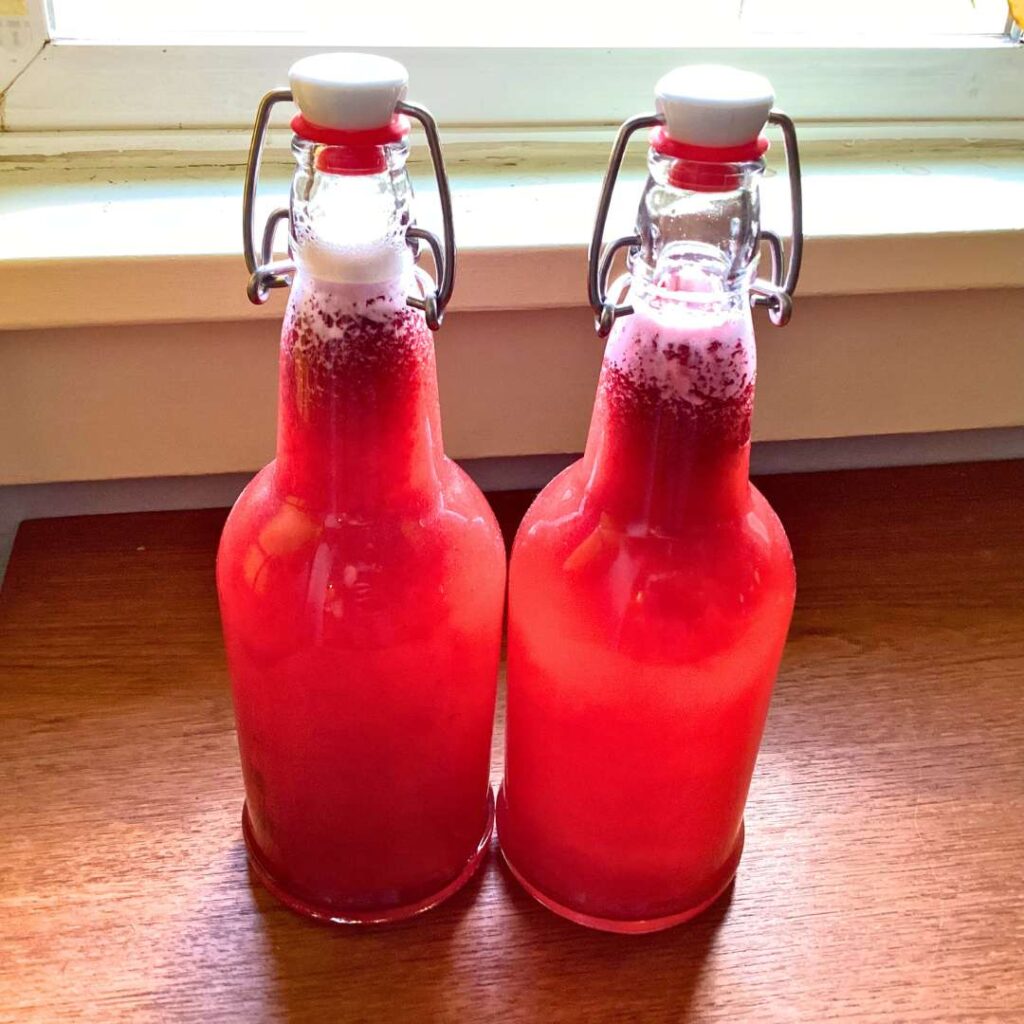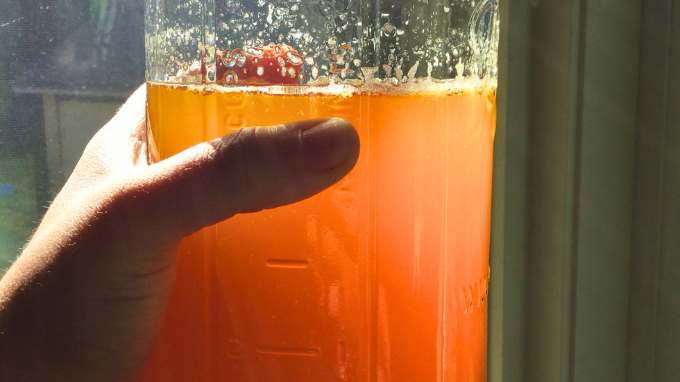Make fermented drinks at home. Here’s what you need to know to start. Stop buying store bought kombucha, start saving money and brew these magical elixirs yourself! It’s super easy to make homemade fermented drinks.
I cannot express the depths to which I enjoy making fermented sodas at home. The following text is answers to many common questions that I get. This is real brass tacks information. What I wish to convey here first is how unbelievably satisfying it is to make such a special treat from scratch in your own kitchen. The fast that it takes day or weeks to complete just makes it ever more exciting.
The anticipation when waiting for these ferments to finish, the excitement when popping a top and waiting to see how carbonated it will be. These moments are what we live for here on the Greener Postures Homestead. How satisfying it is to make a drink that I can share with my kids without guilt or worry. Full of real food, probiotics and a very low amount of sugar, I can feel good about sharing these drinks with the whole family.

What are fermented drinks?
Fermented drinks are any beverage made by fermentation. Fermentation is a bacterial process that breaks down carbohydrate and sugar. As a byproduct it creates acids, yeast carbon dioxide and probiotics.
Are all fermented drinks alcoholic?
No, some fermented drinks are considered to be more like sodas. There is always some alcohol create by the fermentation process, but many recipes can yield negligible amounts of alcohol and be just fine for kids.
Common fermented alcoholic drinks are beer, wine, mead and liquors.
I focus on brewing non-alcoholic drinks in my home. Good stuff the whole family can enjoy.
What are some nonalcoholic fermented drinks?
I consider nonalcoholic drinks to be fruit kvass, tepache, kombucha, jun, water kefir, ginger beer and root beer. You can also make wild fermented lemonade and any other fruit drink you desire. All these drinks will have at least a trace amount of alcohol. The amount depends on many factors. You can have some control over this if you are making fermented drinks at home.

Are fermented drinks easy to make at home?
Yes! Many fermented drinks are incredible simple to make. Others are a little more fussy and take extra care. There is a fermented drink for any skill and commitment level.
What equipment do you need to make fermented drinks at home?
Equipment:
All links below are items I own and use to ferment beverages.
- gallon size glass jar
- Spoon or ladle
- Measuring cups
- Cutting board
- Knife
- Cloth or coffee filter
- Rubber band
- Fine mesh strainer
- Bottle funnel
- Canning funnel
- Swing top bottles
What ingredients do you need to make fermented drinks at home?
The ingredients vary depending on what type of fermented drink you are making. Some fermented drinks take simple ingredients that you likely already have on hand. Others need special starter cultures or SCOBY’s that you can grow or buy from a store. I share some examples below:
- Water Kefir – water kefir grains, sugar, water, fruit or fruit juice (optional)
- Kombucha – kombucha SCOBY, sugar, black tea, water, fruit or fruit juice (optional)
- Jun Kombucha – jun kombucha SCOBY, honey, green tea, water, fruit or fruit juice (optional)
- Fruit Kvass – water, fruit, sugar
- Tepache – peel and core of a pineapple, sugar or piloncillo, water, spices (optional)
- Ginger Beer – ginger, water, sugar, ginger bug starter
- Root Beer – root beer herbs and spices, sugar, water, ginger bug starter

What directions do you need to follow to make fermented drinks?
The method for making fermented drinks depends on what you’re making. It ranges from extremely simple to somewhat complex.
How long does it take to ferment a drink?
This also depends on what kind of fermented drink you’re making. Kombucha takes much longer than water kefir or kvass. Kvass can be ready to bottle in just a few days.
Some factors that decide the length of time to ferment a drink is the ambient room temperature in your environment. If your house is very warm, it will ferment faster, if it’s on the cooler side, it will take longer.
The optimal temperature for fermenting kombucha is about 75-85 F . Fermentation won’t occur if it’s too cool. You probably won’ have any luck if it’s 60 F or below.

What is a perpetual ferment?
I honestly don’t know if anyone else calls it this, but I call certain things perpetual or rhythm ferments. These are the types of drinks or foods that have active cultures or SCOBY’s that you have to feed and care for to keep alive. When your beverages is done, save these cultures and reuse them in a new drink. Well cared for cultures can make an infinite number of batches. It’s like keeping a pet, but unlike a pet it provides you with delicious probiotic rich food and drink.
What is a SCOBY?
SCOBY stands for Symbiotic Culture of Bacteria and Yeast, and that’s just what it is. These are starter cultures used to make fermented food batch after batch. They are growing, living things. When healthy they will grow and reproduce as they work their magic.
Examples of SCOBY’s are kombucha SCOBY’s and water kefir or milk kefir grains.

What are kefir grains?
Kefir grains can refer to water kefir or milk kefir grains. These SCOBY’s are small and look a bit like jelly or cottage cheese. You can strain them and reuse them in new ferments. They need to be fed and cared for, when they are they will grow and thrive.
Are fermented drinks carbonated?
Carbon dioxide is a natural byproduct of the fermentation process. Fortunately for us, we can use this byproduct to make a delicious fizzy drink. By trapping the c02 into a bottle and letting it build up you can yield a yummy effervescent soda. That is natural carbonation.
On the flip side, if you trap in too much c02 you can end up with a foamy mess when you open your bottle. Even worse yet, you could end up with an exploding glass bottle. That is why it’s important to make sure any swing top bottles you buy are fermentation grade. Fermentation grade glass bottles are designed to hold more pressure.
My favorite way to avoid soda eruptions is to use the plastic bottle method for my secondary ferment.

What is the plastic bottle method?
Plastic bottle method just means to use a plastic bottle for the secondary ferment. Basically I just strain some of the drink into a plastic bottle. This plastic bottle will act as my gauge to see how much pressure is building up during the secondary fermentation process.
Give a plastic bottle a little squeeze and you will see that it has some give. When you start to feel the bottle is tight, it’s time to move your bottles of fermented drinks into the fridge.
You can use any plastic bottle. Usually I buy a plain sparking water in a 16 oz bottle and safe that. I only use one and bottle the rest in glass. I use the plastic one as the gauge for all the bottles. If they are all the same size, with the same contents and same conditions one bottle should work for keeping an eye on all of them.
What is secondary fermentation?
Secondary fermentation, second ferment or sometimes called 2F is the step in making fermented beverages where you strain your liquid and move it into a sealed bottle. This is the time you can flavor your drink with crushed fruit, herbs or juice. After it’s bottles it will continue to sit at room temperature to build up carbonation. That is the second ferment.

Are fermented drinks high in sugar?
The absolute best part about making fermented soda at home is that you have control over how much and what goes into your brew. The sugar in my homemade drinks are a fraction of anything you can buy at the store.
The amount of sugar in a finished ferment is less than what goes into the bottle. That’s because the fermentation process metabolizes sugars and converts them into acids. By fermenting your beverage, you are reducing the overall amount of sugar in your drinks.
The longer you ferment a drink, the less sugary and more acidic it becomes. You can ferment kombucha for just a week or 10 days, or you can let it go for 20-30 days. What you end up with as you final product will be wildly different. One tasting more sweet and they other more sour and vinegary.
In conclusion
Fermented drinks are sodas that you can make at home with simple real food ingredients. They are full of probiotics, vitamins and minerals and relatively low in sugar.
If you are looking for a alternative to conventional store bought sodas or big brand kombuchas, getting started with making fermented beverages at home is a great option.
This is just the tip of the iceberg. Learn more about fermented drinks by doing. Pick one that is interesting to you and dive in! I am working on writing up many more of my recipes so check back for more details on how I make fermented drinks at home. For now, check out the links below.

Leave a Reply